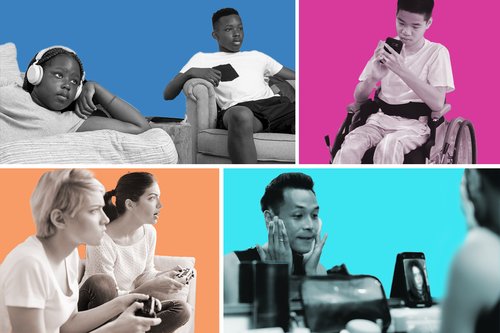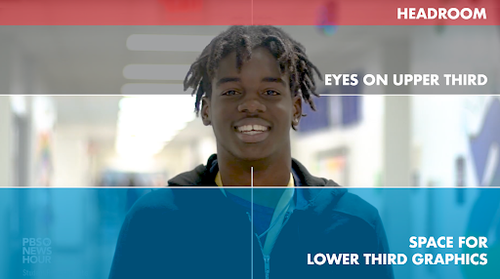
Let’s talk pop culture.
There’s been a lot of conversation lately about the importance of representation in media—across film, television, music, sports, video games, and books. Whether we're talking about race, gender, disability, socioeconomic background, or sexual orientation, many believe pop culture still falls short of fully reflecting the diversity of our world.
While there have been notable strides toward inclusivity fueled by growing demand for authentic and varied portrayals, true representation remains a work in progress. Some groups, like Latinos, Indigenous peoples, and individuals with disabilities, continue to be underrepresented. The ongoing conversation around diversity in pop culture highlights the need for continued progress to ensure that all communities are seen, heard, and valued.
In this lesson, students will explore representation in pop culture through portrait-style interviews.
If you plan on having a classroom discussion before assigning this challenge, use this Classroom Conversations Guide to help students feel prepared and supported.
Students will be able to:
Here is a list of alternative wordings of the questions, which could be helpful with your interview.
Interview subjects should look straight to camera and answer the questions in complete sentences or include the question in their answers so that viewers understand the context.
EXAMPLE OF DESIRED COMPOSITION:

ON CAMERA IDENTIFICATION: Interviewers should ask subjects the following - For the record, please say and spell your full name (first and last) on camera. Also please describe how you want to be identified in this video. For example, “I’m an 11th grade student at Canyon High School in Santa Clarita, California”
Warm Up:
Begin with a class discussion about what pop culture is and how it influences society. Invite students to share examples they engage with regularly—such as favorite movies, TV shows, music, games, or influencers. Introduce the concept of inclusive representation in pop culture and why it matters for individuals and communities.
Historical Context:
Provide a brief overview of how representation in pop culture has evolved over time. Highlight key milestones and influential figures who have advanced diversity and inclusion. Acknowledge the progress made, while also addressing ongoing gaps and challenges.
Media Analysis Activity:
Class Discussion:
Facilitate a whole-class conversation based on the group presentations. Encourage students to reflect on how media representation shapes perceptions and impacts societal attitudes. Explore the importance of pushing for continued progress toward inclusive and equitable portrayals.
Conclusion:
Recap the key themes from the lesson, emphasizing the power of media representation and the role of audiences in shaping pop culture. Encourage students to become more conscious consumers and advocates for diverse and authentic storytelling.
Reflection Assignment (Optional):
Ask students to write a short essay analyzing a piece of pop culture they feel is either inclusive or lacking in representation. They should explain their perspective and suggest thoughtful ways to improve or strengthen inclusivity.
Global Perspective (Optional Extension):
Introduce a global lens by discussing how inclusivity in pop culture varies across different countries and cultures. Acknowledge that while there have been global strides toward representation, disparities persist, especially for Indigenous communities, people with disabilities, and others often excluded from mainstream narratives.
This resource is part of the Global Education Toolkit and was made possible with support from the Longview Foundation.
Media refers to all electronic or digital means and print or artistic visuals used to transmit messages.
A simplified and standardized conception or image invested with special meaning and held in common by members of a group; a set form or convention
The condition of having or being composed of differing elements. Especially in the context of the inclusion of people of different races, cultures, etc. in a group or organization
The act or practice of including and accommodating people who have historically been excluded (as because of their race, gender, sexuality, or ability)
Historical inquiry is based on materials left from the past that can be studied and analyzed. (NCSS D2.His.9.9-12 - D2.His.13.9-12)
Civics teaches the principles—such as adherence to the social contract, consent of the governed, limited government, legitimate authority, federalism, and separation of powers—that are meant to guide official institutions such as legislatures, courts, and government agencies. (NCSS D2.Civ.7.9-12 - D2.Civ.10.9-12)
Determine the kinds of sources that will be helpful in answering compelling and supporting questions, taking into consideration multiple points of view represented in the sources, the types of sources available, and the potential uses of the sources. (NCSS D1.5.9-12)
Explain points of agreement and disagreement experts have about interpretations and applications of disciplinary concepts and ideas associated with a supporting question and explain how supporting questions contribute to an inquiry and how, through engaging source work, new compelling and supporting questions emerge. (NCSS D1.3.9-12 - D1.4.9-12)
Students recognize the responsibilities and opportunities for positively contributing to their digital communities. (ISTE)
Whether students are constructing opinions, explanation, or arguments, they will gather information from a variety of sources and evaluate the relevance of that information. (NCSS D3.1.9-12 - D3.2.9-12)
Civics is the discipline of the social studies most directly concerned with the processes and rules by which groups of people make decisions, govern themselves, and address public problems. (NCSS D2.Civ.11.9-12 - D2.Civ.14.9-12)
Students communicate clearly and express themselves creatively for a variety of purposes using the platforms, tools, styles, formats and digital media appropriate to their goals. (ISTE)
Representation
Stereotypes and Misconceptions
Arts
Identity
Projects
Beginner
Intermediate
Advanced
White board, chalkboard or other visual board
Camera or Mobile Phone
Internet
Notebook
50 Minutes